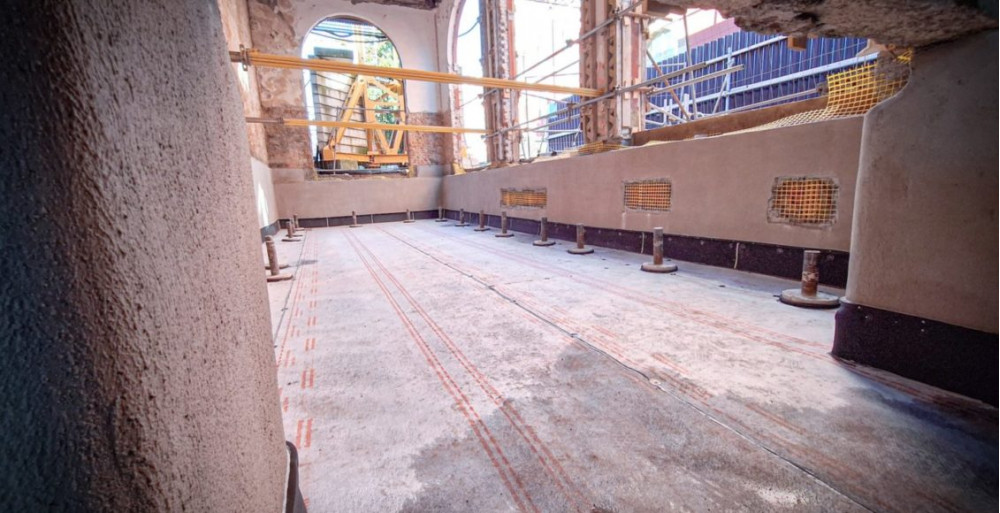One of the main issues in construction is the waterproofing of foundations, especially in cities built on marshlands and canals, subject to infiltration of brackish water.
Another critical phenomenon is capillary rise, which causes salt to deposit on masonry, leading to the deterioration of plasters and mortars, resulting in aesthetic, structural, and health-related damage to buildings.
In Venice, the various high tide events have further highlighted how fragile this heritage is and how, in its uniqueness, it can and must be protected.
In this sense, the fight against water begins with the waterproofing of buildings in the historic center of Venice, which are periodically subject to flooding due to rising tides.
This type of intervention on historic buildings represents one of the highest expressions of waterproofing design.

Volteco | Fondaco dei Turchi in Venice. Waterproofing of tanks against high tides in the 1990s. Source: https://www.youbuildweb.it/
The evolution of the Volteco method
From bentonite panels to innovations with waterproof mortars and synthetic membranes, Volteco, founded in 1976, has introduced many innovative products for the waterproofing sector throughout its history.
Through constructive dialogue with engineers working in the Venetian territory, the concept of a tank to protect against tides began to develop.
In 1978, the Volclay Panel system was launched. It involved installing bentonite panels on the base and vertically on the masonry, followed by the casting of the slab and retaining walls.
The initial concept of recreating a sealed basin has remained the same, even though the technologies used have been progressively improved and optimized. This led to the development of the bentonite membrane Volgrip, later integrated with the thick waterproof plaster Bi Mortar Plaster Seal.
The use of Volgrip simplified installation operations. The restoration and rehabilitation activities of buildings in the historic center of Venice are heavily influenced by the fluctuations of the tides.
Being able to intervene quickly and effectively, when environmental conditions allow, is a crucial aspect for effectively organizing construction work.
Moreover, the thick waterproof plaster Bi Mortar Plaster Seal allowed for the waterproofing of masonry without reducing internal space or the value of the buildings.

Volteco | Application of the Volgrip bentonite sheet Source: https://www.youbuildweb.it/
The year of Amphibia 3000 Grip
In 2017, with the launch of Amphibia 3000 Grip, a cutting-edge solution was introduced for protecting structures from water infiltration.
This complete waterproofing system allows for the sealing of penetrations and construction details—critical aspects during the design phase.
Amphibia 3000 Grip also offers practicality, fast application, and reliable long-term waterproofing.
Due to Venice’s peculiar layout, the supply and movement of construction materials are particularly challenging.
Amphibia 3000 Grip, aside from being a major technological upgrade over bentonite membranes, is also significantly lighter in weight.
This feature makes it easier to use in environments and spaces with difficult access.

Volteco | Application of Bi Mortar Plaster Seal waterproof plaster Source: https://www.youbuildweb.it/

Volteco | Applicazione della membrana impermeabile Amphibia 3000 Grip Source: https://www.youbuildweb.it/
Field experience | Stefano Maccatrozzo | Technical Sales Assistant, Volteco
How has waterproofing in Venice changed over the past 35 years?
The recovery of tanks against high tides has always been essential. In the past, before Volteco had developed current technologies, traditional methods such as concrete slabs and retaining walls were used.
However, these solutions had technical drawbacks and caused a significant loss of space—an important issue considering the high square meter cost in Venice.
Over the years, we’ve managed to intervene in a less invasive way, optimizing operational phases and improving the safety of rehabilitation—always in full respect of Venice’s artistic heritage.
What are the biggest challenges you’ve faced in these 35 years?
Compared to years ago, today there’s greater sensitivity toward rehabilitating ground floors. In the last decade, tides have become more intense and frequent, even outside the traditional autumn season (formerly limited to November and December).
Rehabilitating ground floors—for commercial, tourist, or residential spaces—has contributed to making Venice even more attractive, improving and expanding the city’s offerings. One of the most significant memories is the intervention carried out in 2000 at Punta della Dogana, now used as a museum.
It was a complex site due to its location and the type of intervention for waterproofing the tank against high tides and a basement floor, which brought new life to a symbolic building of Venice. Another major intervention, also in the early 2000s, was at Teatro La Fenice.
On that occasion, we waterproofed the entire basement floor, down to 4 meters deep, transforming it into a storage area for stage machinery and musicians’ and artists’ equipment. A highly responsible job that created functional new spaces for one of the world’s most prestigious theaters.
Tell us about the experience in 2019—an annus horribilis for Venice.
Starting from November 12 that year, Venice went through a dramatic month marked by repeated high tide episodes, with peaks up to 189 cm. These events were irrefutable confirmation of ongoing climate change.
The increasing intensity of such extreme phenomena made it even more evident how fragile Venice is, and how it must be protected with utmost attention in terms of its historical, touristic, and economic value.
During that period, I personally verified the condition of interventions carried out with our most advanced technologies.
The results proved the effectiveness of the adopted solutions, giving us even more confidence and strength in our work.
Source: https://www.youbuildweb.it/





